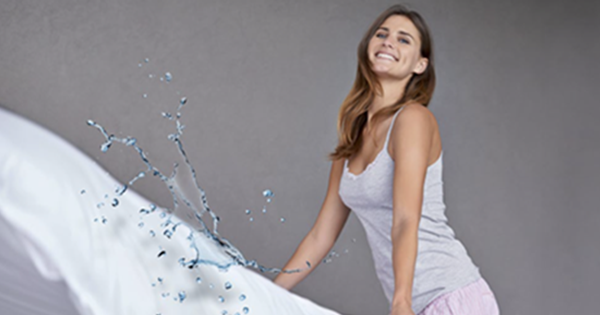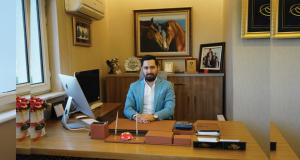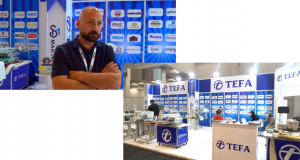Not too hot and not too cold! Intelligent textiles have transitioned their way into the daily life of consumers. The same textiles that provide astronauts in space and researchers in the Antarctica the necessary protection for their jobs can also be useful for the normal public.
Heat managing phase change materials (PCM) by the market leader Outlast can now be found in numerous everyday products: from apparel, underwear, socks or shoes to bedding, along with some recent products in orthopedic devices.
Outlast® phase change materials provide an optimum climate, where unpleasant temperature changes are balanced and sweating can be reduced significantly – this is done proactively before the onset of sweat. Numerous orthopedic products take advantage of these benefits. Some innovative manufacturers are already utilizing the smart Outlast® material: The Ohio Willow Wood Company, Mt. Sterling/Ohio, uses Outlast® PCM in prosthetic liners to reduce sweating dramatically. Until now, all prosthetic liners have acted as insulators, holding heat from the residual limb within the liner and causing the amputee to sweat. The Alpha® SmartTemp Liner blends silicone with Outlast® heat management technology, enabling the liner to absorb and store heat to prevent the long-standing issue of perspiration in prostheses. Outlast® technology in the Alpha® SmartTemp Liner is proactive, meaning that it continuously reacts to the user’s skin temperature to help mitigate the onset of sweating. This differs from reactive solutions, such as wicking, which require the user to sweat and become uncomfortable before the technology kicks in.
WillowWood performed clinical testing on the Alpha® SmartTemp Liner. During this testing, several amputee patients reported they could wear the liner 14 to 20 hours without having to remove it. While each user’s activity level, environment and personal metabolism contribute to the liner’s performance, all amputees who wore the Alpha® SmartTemp Liner received noticeable benefits from the Outlast® technology.
Other orthotic products (for shoulder, hand, hand wrist, knee, lower legs) made by Otto Bock, also provide a “comfortable microclimate due to less sweat production“. Outlast® foam cushions inside of ankle orthoses made by the French company Thuasne offer an optimum climate. The German company Hydas Fabrik für Medizinalbedarf GmbH, Frankfurt, uses Outlast® fibers in different bandages/supporting belts for extended heat management. In addition, compression bandages by Bort GmbH, Weinstadt-Benzach/Germany, promise exceptional comfort due to Outlast® PCM.
How it works
But how do PCMs work? Not too hot, not too cold – just right. That is the easy way it works. Pioneer and market leader is the American company Outlast Technologies LLC, headquartered in Golden/Colorado, regarding the research, development, design and marketing of temperature regulating phase change materials (PCM). The PCM technology Outlast® was originally developed for NASA to protect astronauts against the extreme temperature changes in space. Outlast® technology utilizes phase change materials (PCM) that proactively absorb heat, store it and release it for optimal thermal comfort. Big advantage: Sweat production is significantly reduced.
Proactive climate regulation
Outlast® technology is comparable to ice in a drink; as it changes from solid to liquid, it absorbs heat and cools the drink, keeping that drink at the desired temperature for a longer period of time. Outlast® phase change materials work in the same way. The PCMs have the capacity to absorb, store and release excess heat. This gives any product containing Outlast® technology the ability to continually regulate the skin’s microclimate. As the skin gets hot, the heat is absorbed, and as it cools, that heat is released. Outlast® technology is not wicking technology, which manages moisture by reacting to your sweat and pulling it away from the skin. Outlast® technology will proactively manage heat while controlling the production of moisture before it begins. That’s the Outlast® difference. The benefits of Outlast® products at a glance:
- Absorbs excess body heat § Manages moisture § Reduces overheating § Reduces chilling
- Reduces perspiration § Continuously adapts to thermal changes
What is affected by the PCM is the microclimate on the skin. How sensitive the human body is to temperature fluctuation here becomes clear looking at the small range of the comfort zone: The human body temperature is 36.6°C on average. The inner temperature (e.g. heart, kidneys…) is the core temperature and ranges between small limitations, normally it is 37°C. The shell temperature of the skin and limbs as a rule is lower and varies between 28°C and 33°C. If the normal temperature between 36.5°C and 37.4°C differs slightly at the top, we are talking of fever, if it sinks below it leads to hypothermia. If this range can be positively influenced by dynamically working Outlast® materials it is possible to maintain the personal comfort zone and to reduce annoying peeks of being too warm or too cold. Especially looking at prosthesis this brings a special plus for comfort.
Complete PCM spectrum
All in all Outlast works on an exciting, wide field and offers as only supplier a very large spectrum of climate regulating PCM options. Not to forget: The Outlast® performance products are accompanied by an elaborated marketing package including labels and hangtags or POS materials or trainings offered for free.
#Outlast, #heatmanage, #PCM, Intelligenttextile, #SmartTemp
 SleepTech Magazine Mattress, Accessories, Machinery, Raw Materials
SleepTech Magazine Mattress, Accessories, Machinery, Raw Materials




